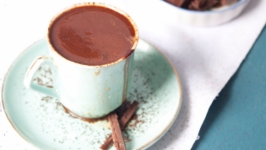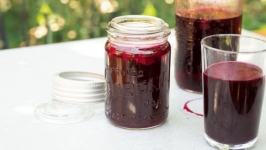Pleased with Punch
Punch has a reputation for going down too easily and many have com- plained of a hangover the next day. They are bound to blame the “sugar” rather than their own tendency to overindulge. Perhaps you’re caught up in the merriment, the retro Mad Men vibe of it all. How often do you drink punch? Maybe it’s about the reluctance to break with solidarity—who are you to abandon your fellow guests? Or it could be that you just enjoy the conviviality that punch affords. What could be better than sharing a toast with friends old and new?
It’s that element of merrymaking that gets me every time. And let’s face it: I’m not the only one. Punch is popular in many forms in many countries. We tend to associate it with holiday celebrations, but as early as the seventeenth century, people were drinking punch at any old time.
The British East India Company stocked its ships with beer when they travelled to India. But because of the distance, the beer often spoiled by the time they arrived, and the sailors were no less thirsty. So they took up the local habits and enjoyed the available spirits mixed with fruit and with spices— most notably nutmeg. The main spirit found on the Indian subcontinent and in South East Asia was arrack. (Made from palm wine, it is not to be confused with the aniseed-flavoured arak, which is still popular in the Middle East). When British ships travelled to the Caribbean, rum became the anchor of the drink, and it remains closely associated with punch today.
There are a few theories about where the name came from. Puncheon—a word whose infrequent use I lament—means a barrel for transporting wine and spirits. It became known as a measure of such things, as well as the name given to a type of Caribbean rum. Another theory attributes it to panch, the Sanskrit name for five, because punch contained 5 elements: strong, weak, sweet, sour, and spice. This also gives us the recipe, remembered with the help of a popular Barbadian rhyme.
Once you divert from a spirit like rum for the strong element, the ratios in the rhyming recipe work less well, but be sure your recipe includes elements of strong, weak, sweet, sour, and spice. The inclusion of wine makes the strong element less strong so sometimes a little adjustment to the recipe is needed.
The British and other Europeans soon brought punch back to their home countries. And the monteith, a huge silver bowl introduced in the seventeenth century, with a scalloped edge for hanging glasses to chill in ice water, became the perfect vessel from which to serve punch. Later, Charles Dickens, who was a big fan of punch—and of lighting it on fire—recommended using an old bowl you didn’t care about in case it should break.
Whether your bowl is silver or glass, old or new, makes little difference. What’s important is that it be large enough for sharing. The element not mentioned in the rhyme is of course the willing participants. That’s what makes it a party.








